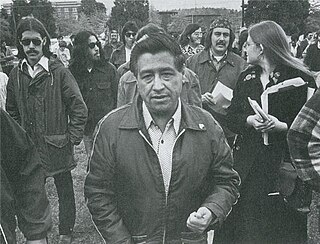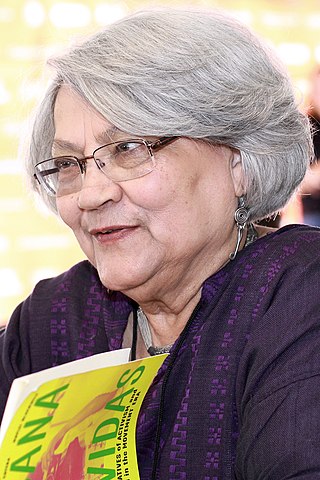Related Research Articles

Chicano or Chicana is an ethnic identity for Mexican Americans who have a non-Anglo self-image, embracing their Mexican Native ancestry. Chicano was originally a classist and racist slur used toward low-income Mexicans that was reclaimed in the 1940s among youth who belonged to the Pachuco and Pachuca subculture. In the 1960s, Chicano was widely reclaimed in the building of a movement toward political empowerment, ethnic solidarity, and pride in being of indigenous descent. Chicano developed its own meaning separate from Mexican American identity. Youth in barrios rejected cultural assimilation into whiteness and embraced their own identity and worldview as a form of empowerment and resistance. The community forged an independent political and cultural movement, sometimes working alongside the Black power movement.

El Plan de Santa Bárbara: A Chicano Plan for Higher Education is a 155-page document, which was written in 1969 by the Chicano Coordinating Council on Higher Education. Drafted at the University of California Santa Barbara, it is a blueprint for the inception of Chicana/o studies programs in colleges and universities throughout the US. The Chicano Coordinating Council expresses political mobilization to be dependent upon political consciousness, thus the institution of education is targeted as the platform to raise political conscious amongst Chicanos and spur higher learning to political action. The Plan proposes a curriculum in Chicano studies, the role of community control in Chicano education and the necessity of Chicano political independence. The document was a framework for educational and curriculum goals for the Chicano movements within the institution of education, while being the foundation for the Chicano student group Movimiento Estudiantil Chicano de Aztlán (MEChA).
Moctesuma Esparza is an American producer, entertainment executive, entrepreneur and community activist. He is the chief executive officer of Maya Cinemas, a theater chain servicing to the United States Latino audience. He is also a partner with Carolyn Caldera in the company Esparza/Caldera Entertainment. He founded film distribution and production company Maya Entertainment in 2007.

The Chicano Movement, also referred to as El Movimiento, was a social and political movement in the United States that worked to embrace a Chicano/a identity and worldview that combated structural racism, encouraged cultural revitalization, and achieved community empowerment by rejecting assimilation. Chicanos also expressed solidarity and defined their culture through the development of Chicano art during El Movimiento, and stood firm in preserving their religion.

Lourdes Portillo is a Mexican film director, producer, and writer.

Luis Miguel Valdez is an American playwright, screenwriter, film director and actor. Regarded as the father of Chicano film and playwriting, Valdez is best known for his play Zoot Suit, his movie La Bamba, and his creation of El Teatro Campesino. A pioneer in the Chicano Movement, Valdez broadened the scope of theatre and arts of the Chicano community.

Chicana feminism is a sociopolitical movement, theory, and praxis that scrutinizes the historical, cultural, spiritual, educational, and economic intersections impacting Chicanas and the Chicana/o community in the United States. Chicana feminism empowers women to challenge institutionalized social norms and regards anyone a feminist who fights for the end of women's oppression in the community.

Yolanda Margarita López was an American painter, printmaker, educator, and film producer. She was known for her Chicana feminist works focusing on the experiences of Mexican-American women, often challenging the ethnic stereotypes associated with them. Lopez was recognized for her series of paintings which re-imagined the image of the Virgen de Guadalupe. Her work is held in several public collections including the Smithsonian American Art Museum, the San Francisco Museum of Modern Art, and the Los Angeles County Museum of Art.

Chicano poetry is a subgenre of Chicano literature that stems from the cultural consciousness developed in the Chicano Movement. Chicano poetry has its roots in the reclamation of Chicana/o as an identity of empowerment rather than denigration. As a literary field, Chicano poetry emerged in the 1960s and formed its own independent literary current and voice.

The UCLA Chicano Studies Research Center (CSRC) was founded in 1969 to foster multidisciplinary research efforts at the University of California, Los Angeles (UCLA). It is one of four ethnic studies centers established at UCLA that year, all of which were the first in the nation and have advanced our understanding of the essential contributions of people of color to U.S. history, thought, and culture. The centers remain the major organized research units in the University of California system that focus on ethnic and racial communities and contribute to the system's research mission.

Carmen Lomas Garza is an Chicana artist and illustrator. She is well known for her paintings, ofrendas and for her papel picado work inspired by her Mexican-American heritage. Her work is a part of the permanent collections of the Smithsonian American Art Museum, the Hirshhorn Museum and Sculpture Garden, the National Museum of Mexican Art, the San Jose Museum of Art, the Mexican Museum, the Pennsylvania Academy of the Fine Arts, and the Oakland Museum of California, among other institutions.

The National Film Registry (NFR) is the United States National Film Preservation Board's (NFPB) collection of films selected for preservation, each selected for its historical, cultural, and aesthetic contributions since the NFPB's inception in 1988.

Martha P. Cotera is a librarian, writer, and influential activist of both the Chicano Civil Rights Movement and the Chicana Feminist movement of the 1960s and 1970s. Her two most notable works are Diosa y Hembra: The History and Heritage of Chicanas in the U.S. and The Chicana Feminist. Cotera was one of six women featured in a documentary, Las Mujeres de la Caucus Chicana, which recounts the experiences of some of the Chicana participants of the 1977 National Women's Conference in Houston, Texas.
The Bronze Screen directed and produced by Susan Racho, and Alberto Dominguez, examines, analyzes, and critiques the portrayal of Latinos in Hollywood over the course of a century. Released in 2002, the documentary traces the different stereotypes evoked by Hollywood throughout the mid 19th and 20th century. This is done through the use of silent films and small excerpts from a variety of movie genres that feature Latinos. Carmen Miranda and Margarita Cansino are a few of the many Latin actors and actresses whose careers, according to film historians, directors, and fellow actors featured in the documentary, were fabricated and highly manipulated by Hollywood. Furthermore, these actresses are used to illustrate the politics behind American Cinema and Latino/a negative representations in Hollywood. In addition to exploring stereotypes and negative representations of Latinos, The Bronze Screen also acknowledges the contribution and emergence of Latino writers, directors, cinematographers, composers, and graphic designers. Luis Valdez, Pablo Ferro, Moctesuma Esparza, and John Alonzo are a few, among the many featured in the documentary, that have paved the way for other Latinos who want to work in the industry, as well as, portrayed Latinos in a more positive manner through their films.

Sylvia Morales is an American film director, writer, producer, and editor. Morales is recognized as one of the first female Mexican-American filmmakers to have established a Latino cinema. In her filmmaking career, Morales has been nationally recognized winning awards for film and video documentary on topics ranging from the farm workers struggle to the music of Los Lobos.
Yreina Cervantez is an American artist and Chicana activist who is known for her multimedia painting, murals, and printmaking. She has exhibited nationally and internationally, and her work is in the permanent collections of the Smithsonian American Art Museum, The Mexican Museum, the Los Angeles County Museum, and the Los Angeles Museum of Contemporary Art.

Please, Don't Bury Me Alive! is a 1976 independent film directed by and starring Efraín Gutiérrez and written by Sabino Garza. It is considered to be the first Chicano feature film. In its first four months of showing, the film made $300,000 at the local box offices where it was shown.

Chicana art emerged as part of the Chicano Movement in the 1960s. It used art to express political and social resistance through different art mediums. Chicana artists explore and interrogate traditional Mexican-American values and embody feminist themes through different mediums such as murals, painting, and photography. The momentum created from the Chicano Movement spurred a Chicano Renaissance among Chicanas and Chicanos. Artists voiced their concerns about opression and empowerment in all areas of race, gender, class, and sexuality. Chicana feminist artists and Anglo-feminist took a different approach in the way they collaborated and made their work during the 1970's. Chicana feminist artists utilized artistic collaborations and collectives that included men, while Anglo-feminist artists generally utilized women-only participants.Art has been used as a cultural reclamation process for Chicana and Chicano artists allowing them to be proud of their roots by combining art styles to illustrate their multi-cultured lives.

Chicano cinema is an aspect of Mexican American cinema that refers to the filmmaking practices that emerged out of the cultural consciousness developed through the Chicano Movement. Luis Valdez is generally regarded as the first Chicano filmmaker and El Teatro Campesino as the first theater company.
References
- 1 2 "Chicana". www.wmm.com. Retrieved 2023-01-24.
- 1 2 3 "Eight films with UCLA ties among 25 named to the National Film Registry". UCLA. Retrieved 2023-01-24.
- ↑ Fregoso, Rosa Linda (1993). The Bronze Screen: Chicana and Chicano Film Culture. U of Minnesota Press. p. 1. ISBN 978-1-4529-0100-8.
- 1 2 3 4 5 6 7 8 "SELENA and CHICANA Added to the Library of Congress' National Film Registry". Cinema Tropical. Retrieved 2023-01-24.
- 1 2 "'Chicana,' 'Selena' and 'Requiem 29' Named to National Film Registry – Latin Heat" . Retrieved 2023-01-24.